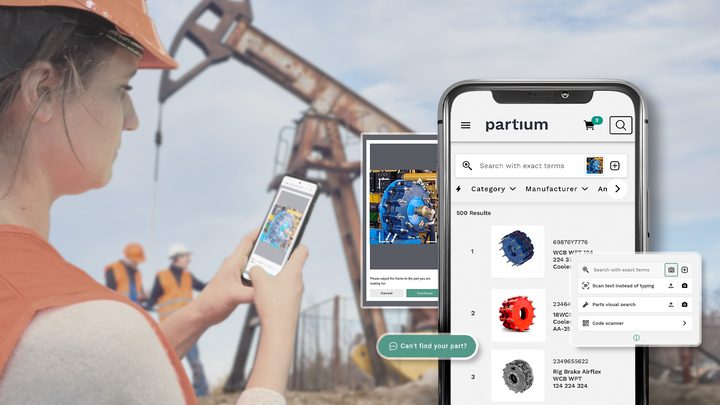AI Spare Parts Search for Maximized Maintenance Efficiency
Maintenance plays a critical role in the energy/utility sector, ensuring the continuous and reliable operation of infrastructure such as power plants, transmission lines, and distribution networks. Regular maintenance activities help prevent equipment failures, minimize downtime, and ensure the safety of workers and the public. In an industry where uninterrupted service is essential for economic and societal functions, effective maintenance practices are vital for optimizing asset performance, reducing operational risks, and meeting regulatory compliance standards. Additionally, proactive maintenance strategies can extend the lifespan of assets, optimize energy efficiency, and ultimately contribute to sustainable operations in the energy/utility sector.
Traditional Spare Parts Search Processes and the Need for Efficiency in Maintenance
Inefficient maintenance undermines both operational efficiency and public confidence in essential services. Traditional spare parts search processes face several challenges in the energy/utility sector. These include:
- Limited Visibility. Difficulty in tracking spare parts inventory across multiple locations, leading to inefficiencies in identifying and sourcing required parts.
- Manual Processes. Reliance on manual methods for spare parts procurement, which are time-consuming and prone to errors, resulting in delays in maintenance activities.
- Inventory Management. Poor inventory management practices, leading to overstocking or stockouts of critical spare parts, impacting maintenance schedules and operational reliability.
- Reactive Approach. Reactive maintenance strategies rather than proactive planning, resulting in increased downtime and higher maintenance costs.
Understanding AI Spare Parts Search
Using artificial intelligence (AI) now in 2024 offers an array of possibilities to improve the search for spare parts in industrial enterprises. Some of the benefits follow.
Improved Day-to-Day Searching for Spare Parts. Today, employees can take photos of the spare parts required and upload these images to the search system directly. AI-supported image recognition identifies the part more quickly, significantly reducing the time spent searching. Integration with text search using large language models (LLM), image searches, and descriptions are combined in one search, resulting in faster, more accurate identification.
Re-Digitization of Unlabeled Spare Parts Inventories. AI systems can help to record and catalog unlabeled or poorly documented spare parts inventories. These inventories can be efficiently digitized and systematically arranged by analyzing images and text data.
Reading PDFs and Other Document Formats. LLMs are able to browse complex documents, such as PDFs, and extract relevant information about spare parts. This includes technical specifications, manufacturer information, and instructions for use, which are important for maintenance. Experts need to check the results but no longer need to search for them themselves.
Optimizing Warehouses. Warehouses can be optimized by identifying spare parts using image recognition (Figure 1), which improves efficiency and warehouse organization. Difficult-to-describe spare parts can be completely packed, stacked, and organized to “wait” until they are needed. They can even be outsourced, making room for fast-moving products.

Successful AI Implementation Case Study
The case study of a large European energy provider, called Wien Energie (Vienna Energy), showcases one example of a successful implementation of such an AI solution. Partium, the solution they are using, streamlines parts search and parts procurement. Partium’s AI part search simplifies and accelerates the process of locating necessary parts and components onsite, reducing downtime and optimizing inventory management.
Currently, two U.S. energy providers are also rolling out Partium to save valuable time and streamline their parts search-related processes. Especially when it comes to field services cases, for instance wind energy and maintaining wind turbines, Partium’s part identification directly onsite comes in handy.
Maximizing Maintenance Efficiency with AI
AI-driven efficiency in maintenance operations contributes significantly to cost savings and increased uptime. Here are some concrete examples:
- AI-Powered Part Search and Inventory Management. AI-driven solutions, such as Partium, streamline parts search and parts procurement. The AI-powered image recognition technology assists in identifying parts visually. By analyzing images of equipment or components, AI algorithms can match them with relevant spare parts from supplier catalogs, streamlining the search process and reducing the likelihood of errors.
- Natural Language Processing (NLP). Implementing NLP capabilities allows utility personnel to search for spare parts using natural language queries. This simplifies the search process and makes it more intuitive for users, improving efficiency and reducing the time required to find the right parts.
- Data Integration and Analysis. Energy and utility companies can integrate data from various sources, including maintenance records, equipment specifications, supplier catalogs, and historical performance data. AI algorithms can analyze this data to identify patterns and correlations, enabling more accurate spare parts search and inventory management.
- Predictive Maintenance and Asset Management. AI algorithms can analyze equipment data to predict potential failures before they occur. By detecting anomalies in machinery performance, maintenance can be scheduled proactively, preventing costly breakdowns and optimizing asset lifespan.
- Enhanced Field Technician Support. AI-enabled systems, such as Partium, provide field technicians with real-time access to crucial (parts) information, manuals, and troubleshooting guides. This ensures they have the necessary support to resolve issues efficiently, minimizing downtime.
- Optimal Resource Allocation. AI algorithms optimize field operations by analyzing data to suggest optimal technician routes and schedules. This not only saves time and resources but also ensures timely responses to maintenance requests.
Joining the Maintenance Revolution
Joining the maintenance revolution offers numerous benefits, including cost savings, increased uptime, improved safety, enhanced reliability, data-driven decision-making, and sustainability. Overall, embracing the maintenance revolution allows companies in the energy/utility sector to stay ahead of the curve, drive operational excellence, and unlock new opportunities for innovation, growth, and success in today’s rapidly evolving business landscape.
—This article was contributed to POWER by Partium. Schedule a discovery call to talk about use cases, relevant data, and timelines. Usually, such a solution can be built in three to four weeks.